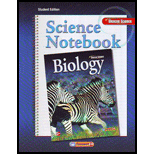
Concept explainers
To fill:
The correct terms according to the given blanks.
Answer to Problem 1NV
The given blanks can be filled as follows:
| S. no. | Correct term |
| 1 | Artery |
| 2 | Capillaries |
| 3 | Veins |
| 4 | Valves |
| 5 | Heart |
| 6 | Pacemaker |
| 7 | Plasma |
| 8 | Red blood cells |
| 9 | White blood cells |
| 10 | Platelets |
| 11 | Atherosclerosis |
Explanation of Solution
The circulatory system of the body is made up of the heart and the blood vessels. Blood vessels that carry oxygenated blood from the heart to the body are called arteries. Nearby tissue arteries are diverged to form a microscopic tubular network called capillaries. The capillaries are the site where the exchange of the gases between tissue and blood takes place.
The capillaries join to form veins, in the veins, the deoxygenated blood is present, in veins, the blood pressure is not high so, it has valves to prevent the backflow of the blood. The veins deliver the blood in the heart and the heart pumps the blood throughout the body. It is a hollow muscular organ. The pacemaker of the heart that is present in the right atrium sends the signal to the heart for pumping the blood.
The blood is the fluid connective tissue which is composed of plasma, white blood cells, red blood cells, platelets, and proteins. The plasma is a clear yellowish fluid that comprises more than 50% of blood. The function of the red blood cells is to transfer the oxygen from the heart to the body. The white blood cells are the cells responsible for immunity and the body’s disease fighting capability. The fragments of the cells that help in blood clotting are known as platelets. The blood clots, fats and other components of blood cause a block to artery resulting in a condition called atherosclerosis.
Additional Science Textbook Solutions
Campbell Biology: Concepts & Connections (8th Edition)
Campbell Essential Biology (7th Edition)
Fundamentals of Anatomy & Physiology Plus Mastering A&P with eText - Access Card Package (10th Edition) (New A&P Titles by Ric Martini and Judi Nath)
Biology: Life on Earth (11th Edition)
Biological Science (6th Edition)
Human Physiology: An Integrated Approach (8th Edition)
 Human Anatomy & Physiology (11th Edition)BiologyISBN:9780134580999Author:Elaine N. Marieb, Katja N. HoehnPublisher:PEARSON
Human Anatomy & Physiology (11th Edition)BiologyISBN:9780134580999Author:Elaine N. Marieb, Katja N. HoehnPublisher:PEARSON Biology 2eBiologyISBN:9781947172517Author:Matthew Douglas, Jung Choi, Mary Ann ClarkPublisher:OpenStax
Biology 2eBiologyISBN:9781947172517Author:Matthew Douglas, Jung Choi, Mary Ann ClarkPublisher:OpenStax Anatomy & PhysiologyBiologyISBN:9781259398629Author:McKinley, Michael P., O'loughlin, Valerie Dean, Bidle, Theresa StouterPublisher:Mcgraw Hill Education,
Anatomy & PhysiologyBiologyISBN:9781259398629Author:McKinley, Michael P., O'loughlin, Valerie Dean, Bidle, Theresa StouterPublisher:Mcgraw Hill Education, Molecular Biology of the Cell (Sixth Edition)BiologyISBN:9780815344322Author:Bruce Alberts, Alexander D. Johnson, Julian Lewis, David Morgan, Martin Raff, Keith Roberts, Peter WalterPublisher:W. W. Norton & Company
Molecular Biology of the Cell (Sixth Edition)BiologyISBN:9780815344322Author:Bruce Alberts, Alexander D. Johnson, Julian Lewis, David Morgan, Martin Raff, Keith Roberts, Peter WalterPublisher:W. W. Norton & Company Laboratory Manual For Human Anatomy & PhysiologyBiologyISBN:9781260159363Author:Martin, Terry R., Prentice-craver, CynthiaPublisher:McGraw-Hill Publishing Co.
Laboratory Manual For Human Anatomy & PhysiologyBiologyISBN:9781260159363Author:Martin, Terry R., Prentice-craver, CynthiaPublisher:McGraw-Hill Publishing Co. Inquiry Into Life (16th Edition)BiologyISBN:9781260231700Author:Sylvia S. Mader, Michael WindelspechtPublisher:McGraw Hill Education
Inquiry Into Life (16th Edition)BiologyISBN:9781260231700Author:Sylvia S. Mader, Michael WindelspechtPublisher:McGraw Hill Education





